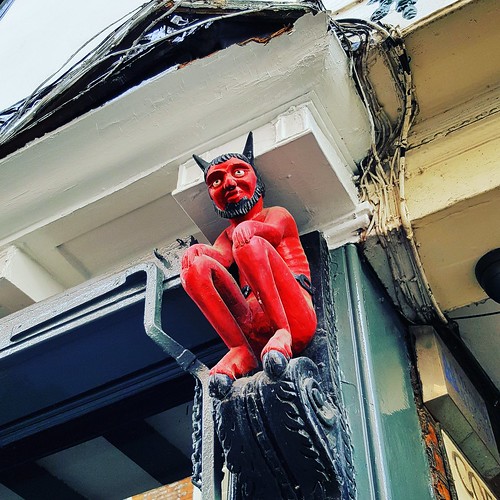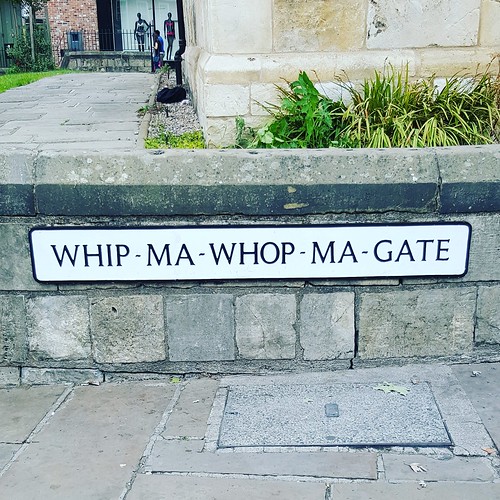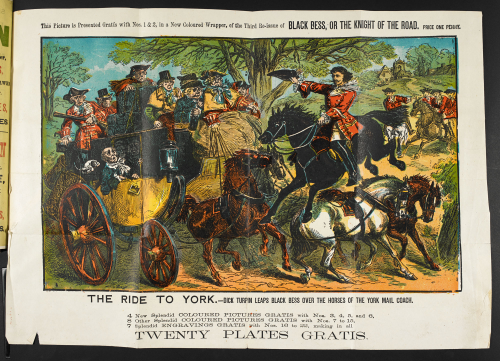York folklore can be a bit tough to search for on Google. It keeps trying to direct you to New York. As if the old one doesn’t exist.
Which is idiotic. The Ghost Research Foundation International even labelled York the most haunted city in the world in 2002 (Crawford 2014). Every pub boasts its own ghost, trying to claim the title of most haunted pub in York.
And it’s true that York does have some spectacular ghost stories. A particular favourite of the ghost walks around the city is the encounter between a heating engineer and a spectral Roman legion marching through the basement of Treasurer’s House in 1953. Much is often made of the fact Harry Martindale could only see the soldiers from the knees up, as they marched along a road that no longer existed (National Trust, n.d.).
But it would be far too easy to dwell on the ghost stories of York. Let’s explore some of the wider folklore of this picturesque English city instead!
York Folklore and the Cat Statues
23 cat statues stand guard on walls or rooftops around York. Well, Secret York says there are “at least” 23 (2024). According to one legend, anyone who sees all of them is cursed for the rest of their life. So who is brave enough to check there are 23?

The York Glass shop clearly doesn’t believe in such a curse. They sell York Lucky Cats and you can follow the York Cat Trail, available from their website. Their free leaflet provides a trail to follow if you want to find the cats, although they only note 22.
The shop’s website theorises that the original statues were to scare off mice or rats that can carry disease. Some intended the statues to ward off spirits too.
This would be no surprise, given the appearance of mummified cats within the walls of old houses. While some assume these cats crawled into a cavity and got stuck, Brian Hoggard notes those found with wires to keep the cat posed as if hunting mice. Perhaps these dried cats acted on a spiritual level to ward off evil spirits, rather than actual mice (2019).
The York Glass shop thinks their original intention was to bestow luck on the medieval city. Yet they’ve passed into York folklore as part of a curse.
If anyone knows anything about the origins of the curse superstition, please leave me a comment! I’d love to dig into it further.
The Stonegate Devil
If you’ve read my post on Newcastle’s Vampire Rabbit, then you’ll know my fascination for weird statues. York has the Stonegate Devil.

A printer’s shop once stood at 33 Stonegate, an area known for printers and bookshops in the 16th century. This carved red devil is a throwback to that era. After all, businesses at the time used such effigies to advertise what they actually did in an early form of branding.
Given the workers operating the presses ended up with blackened fingers thanks to all the ink, some linked them with the dark arts (Seanetta 2021).
Printers had their own folklore and claimed a demon haunted each printer’s shop. These demons inverted type, removed lines or even mis-spelled words. The acts of these ‘printer’s devils’ eventually got transferred to the printer’s own assistant. The assistants became known as ‘printer’s devils’.
While the printing press is long gone, some urban legends claim misfortune will befall you if you look into the devil’s eyes (Seanetta 2021).
Whip-Ma-Whop-Ma-Gate
I couldn’t feature York folklore and not include one of my favourite street names ever.
No one really knows where Whip-Ma-Whop-Ma-Gate, one of the shortest streets in York, got its name.

Some think its original name was ‘Whitnourwhatnourgate’, aka ‘What a Street!’ Others think York’s whipping post stood here in the Middle Ages.
And yet more think it basically means ‘Not One Thing Nor Another’. If that’s true, it makes it the most liminal place in York. Liminal places are usually crossroads or other spaces that aren’t one place or another. This street connects two other streets, so it’s a ‘between’ place of sorts. Though you could say that about a lot of short streets!
Wherever the name came from, the ‘gate’ part of the name comes from the Norse word for street, ‘gata’. So not an actual gate.
A strange place name wouldn’t normally be enough for inclusion on this blog. But Whip-Ma-Whop-Ma-Gate’s general weirdness has earned it a place in York folklore all the same!
Buried Alive in York
I’d heard this story on a ghost walk in York and found it again in a 1901 book about folklore, County Folk-Lore (Gutch 1901: 388). As the legend goes, a wealthy woman died and her family buried some of her jewellery with her. The sexton knew of this and opened the vault after the funeral. But alas! The fingers had swollen and he couldn’t remove her rings.

So he tried to cut off her fingers. As you do. Unfortunately for him (but fortunately for her, as it turns out), she suffered catalepsy. The injury to her fingers broke her trance and she came around. The sexton bolted in fright and the woman went home. She lived for many more years, though hopefully she managed to finally remove the rings herself.
As fantastic a tale as it is, I can’t help thinking it’s just an early urban legend about being buried alive. After all, I heard the exact same story on a London ghost walk. The story relocated to the City. As in this version, the hapless resurrected woman and the thieving sexton remain nameless. That, my friends, is always a sure sign you’re in the presence of an urban legend.
Mary Bateman, the York Witch
Every city needs a good witch story and York is no different. Their version tells the tale of Mary Bateman, the ‘Yorkshire Witch’. She’d left York in disgrace having worked as a servant, and ended up in Leeds. Mary started fortune telling there, although the records claim she conned people out of their property using her “powers”. That would be bad enough, but apparently, she also poisoned people to cover up her fraudulent crimes.
She was hanged on 20 March 1809 at York Castle. Crowds of people paid to view her body. After being dissected, “her skin was tanned and distributed in small pieces to different applicants” (Gutch 1901, p. 143-4).
That sounds gross to us now, but it wasn’t as uncommon as you’d think. Bear in mind this is 1809, well before the 1832 Anatomy Act which allowed surgeons to dissect bodies other than those of criminals. Dissection was inevitable from a convicted witch.
As for the skin? The same fate met notorious Edinburgh bodysnatcher William Burke in 1828. If you pop into The Cadies & Witchery Tours on West Bow in Edinburgh, you can see a card case covered in leather made from Burke’s skin.

The Infamous Midnight Ride to York
If you even run into legends about highwaymen, then you’ll no doubt encounter the belief that Dick Turpin rode from London to York in one night on Black Bess. The York Dungeon even repeats it as fact.
Except it’s not true.
I should note that a few highwaymen get credited with the feat, so it’s difficult to know exactly which one it is. But it is definitely not Dick Turpin since he hadn’t been born when the alleged midnight ride happened.

William Nevison often gets the credit, and appears in Daniel Defoe’s A Tour thro’ the Whole Island of Great Britain, a three-volume series published between 1724 and 1727. Defoe refers to him as Nicks, which already casts doubt on the highwayman’s identity. Some think Defoe may have been talking about Samuel Nicks, another highwayman. We should remember that while Defoe was a journalist, he was writing about an incident that happened fifty years earlier.
But in this legend, Nevison robbed a man at 4 am on Gad’s Hill in Kent in 1676. He rode to York, changing horses along the way, and as soon as he arrived that same afternoon, he made for the nearest bowling green. As luck would have it, the Lord Mayor of York was also there. Nevison contrived to ensure the Mayor knew the exact time and date that he spoke to Nevison by asking him a few questions while he placed a bet.
When accused by the man he had robbed, Nevison produced the Lord Mayor as an alibi. No one believed he could have carried out the robbery in Kent and been in York the same day, therefore he must be innocent. As the legend goes, Charles II was so keen to know if the story was true that he offered him an assurance of a pardon, and when Nevison confessed, Charles II allegedly nicknamed him Swift Nicks.
This royal patronage didn’t last long and Nevison was soon sentenced to deportation to Tangier for another crime. While imprisoned in Leicester gaol, he painted marks onto his skin and took a sleeping draught to create the appearance that he had died of the plague. The gaolers carried him out of the gaol in a coffin, keen not to look too closely lest they contract plague themselves. Nevison allegedly took to highway robbery dressed as his own ghost. Nevison only ever robbed the rich and had a reputation for being polite and non-violent, which led some to compare him to Robin Hood—though there is little evidence he gave his ill-gotten gains to the poor. Still, he was eventually accused of murder and executed in 1684.
While Turpin was caught and executed in York, we really need to stop attributing the midnight ride to him.
What do we make of this York folklore?
There is far more to York folklore than I’ve been able to cover here. As I said in the introduction, York folklore tends to stick to ghosts. Whether it’s spectral Roman legions marching through a cellar or ghostly nuns drifting through pubs, many of the tales revolve around the supernatural.
I’m not sure why, given the Roman and Viking histories of York. Yet luckily these other tales of printer’s devils, lucky cats, witches, premature burial, and highwaymen survive. And they’ll give you something else to look out for when you’re wandering the narrow snickleways and long streets around The Shambles.
References
Crawford, Lisa (2014), ‘Haunted York’, BBC York & North Yorkshire, https://www.bbc.co.uk/northyorkshire/content/articles/2008/10/29/haunted_york_feature.shtml.
Gutch, Eliza (1901), County Folk-Lore, vol. 2: Examples of Printed Folk-Lore Concerning the North Riding of Yorkshire, York, and the Ainsty, London: Published for the Folk-Lore Society by David Nutt.
Hoggard, Brian (2019), Magical House Protection: The Archaeology of Counter-Witchcraft, New York: Berghahn.
National Trust (no date), ‘The ghost stories of Treasurer’s House’, National Trust, https://www.nationaltrust.org.uk/visit/yorkshire/treasurers-house-york/ghosts-of-treasurers-house.
Seanetta (2021), ‘Printer’s Devil’, Atlas Obscura, https://www.atlasobscura.com/places/stonegate-devil.
Secret York (2024), ‘York’s Black Cats’, Secret York, https://secretyork.com/yorks-black-cats/.
Nutty about folklore and want more?
Add your email below and get these posts in your inbox every week.
You'll also get my 5-step guide to protecting your home using folklore!







I always leave your blog posts comfortably spooked, Icy! 😀
Always good to hear!
Wow. This is creepy and intriguing and fascinating all together.
Thank you!
I grew up in York and was told the original cats were left by builders as their building mark. In the 1980’s a local architect Tom Adams repeated this by leaving a cat on his designs in the city centre. A lot of the cats are only 40 years old. The York lucky cats are a relatively new thing as is the Cat Trail more for the tourists than anything. Despite its age and history York is not that spooky ! Apart from the odd Roman ! It’s real history obviously is far more disturbing, persecution, massacre etc
True, but I don’t want to get into a lot of the tales of massacre etc. on the blog. But it’s a shame a lot of the cats aren’t very old! They’re such a lovely idea.
Wonderful article! Thanks for providing this post and I am happy to read this article. I would love to read more blog about it. Keep it up and keep sharing.
My pleasure!
Black cat idols can be used by witches to spy. Practice dates back to Ancient Egyptians, they used to worship an mummify their cats. Cats played a major role in Caananite pagan practices.
Beware of black cats watching you.
The black cat idols are not of God.
Think of it as a witches CCTV network.
Have you got sources for any of that?
No good ones. Plenty of information about Egyptian practices and association between witches and cats. That’s where it comes from. There’s no new ‘magic’. It’s all old fashioned Caanite idolitory and pagan worship. Why the bible warns us about idolitory. It’s clearly a Pagans cheeky joke sticking some cat idols under the shadow of the minster.
Bizarrely enough after responding to your post I see a poster for a ‘Black Cat’ gone missing round our way. Very sad.
I used to own one. Most intelligent pet you could ever wish for.
I no long beleive in coincidence.
I have herd a variation of “The Premature Burial” taking place in the American South during slavery times, told by African American story tellers Ossie Davis and Ruby Dee. Makes you wonder of it isn’t one of those legends that is based on a real occurrence somewhere back in the mists of time.
There‘s a variation to the premature burial story in Germany, which is attached to a particular house in Memmingen (small town in Southern Germany close to the Austrian border).
On the outside of the house, there is a mural of a horse in a cradle, and the story goes like this:
One time, the wife of the owner of this house died and was buried. Him being a well-to-do man, she was put in her finest clothes for her burial and wore her best jewelry. The sexton tried to steal the jewelry, and the woman woke up while he was trying to get her rings off her fingers. The terrified sexton ran away, and the woman took his lantern and went back home. She rang the doorbell and her husband, who was still up, went to the bedroom window to see who was outside. He didn‘t recognise her at first, or at least didn‘t believe this could be real. (I don‘t blame him.)
So he said, „I‘ll sooner find my horse in the cradle than my dead wife at my front door!“
At that moment, there was a loud crash in one of the bedrooms, and when he went to check he found the horse in the cradle. Only then did he believe that the woman at the front door was his wife. She lived for several years more and even had another child.
So, in remembrance of this, he had the horse in the cradle painted on the outside of his house, where the painting still commemorates the event.